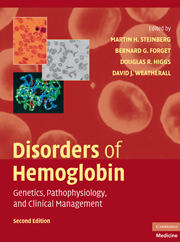Book contents
- Frontmatter
- Contents
- List of Contributors
- Foreword, by H. Franklin Bunn
- Preface
- Introduction, by David J. Weatherall
- SECTION ONE THE MOLECULAR, CELLULAR, AND GENETIC BASIS OF HEMOGLOBIN DISORDERS
- SECTION TWO PATHOPHYSIOLOGY OF HEMOGLOBIN AND ITS DISORDERS
- SECTION THREE α THALASSEMIA
- SECTION FOUR THE β THALASSEMIAS
- SECTION FIVE SICKLE CELL DISEASE
- SECTION SIX OTHER CLINICALLY IMPORTANT DISORDERS OF HEMOGLOBIN
- SECTION SEVEN SPECIAL TOPICS IN HEMOGLOBINOPATHIES
- SECTION EIGHT NEW APPROACHES TO THE TREATMENT OF HEMOGLOBINOPATHIES AND THALASSEMIA
- 29 Transfusion and Iron Chelation Therapy in Thalassemia and Sickle Cell Disease
- 30 Induction of Fetal Hemoglobin in the Treatment of Sickle Cell Disease and β Thalassemia
- 31 Novel Approaches to Treatment
- 32 Stem Cell Transplantation
- 33 Prospects for Gene Therapy of Sickle Cell Disease and Thalassemia
- Index
- Plate section
- References
32 - Stem Cell Transplantation
from SECTION EIGHT - NEW APPROACHES TO THE TREATMENT OF HEMOGLOBINOPATHIES AND THALASSEMIA
Published online by Cambridge University Press: 03 May 2010
- Frontmatter
- Contents
- List of Contributors
- Foreword, by H. Franklin Bunn
- Preface
- Introduction, by David J. Weatherall
- SECTION ONE THE MOLECULAR, CELLULAR, AND GENETIC BASIS OF HEMOGLOBIN DISORDERS
- SECTION TWO PATHOPHYSIOLOGY OF HEMOGLOBIN AND ITS DISORDERS
- SECTION THREE α THALASSEMIA
- SECTION FOUR THE β THALASSEMIAS
- SECTION FIVE SICKLE CELL DISEASE
- SECTION SIX OTHER CLINICALLY IMPORTANT DISORDERS OF HEMOGLOBIN
- SECTION SEVEN SPECIAL TOPICS IN HEMOGLOBINOPATHIES
- SECTION EIGHT NEW APPROACHES TO THE TREATMENT OF HEMOGLOBINOPATHIES AND THALASSEMIA
- 29 Transfusion and Iron Chelation Therapy in Thalassemia and Sickle Cell Disease
- 30 Induction of Fetal Hemoglobin in the Treatment of Sickle Cell Disease and β Thalassemia
- 31 Novel Approaches to Treatment
- 32 Stem Cell Transplantation
- 33 Prospects for Gene Therapy of Sickle Cell Disease and Thalassemia
- Index
- Plate section
- References
Summary
INTRODUCTION
Homozygous β thalassemia is characterized by absent or defective β-globin chain synthesis. This defect causes imbalance in chain production and accumulation of unstable α-globin tetramers in red blood cells or their precursors, leading to intramedullary destruction, apoptosis and hemolytic anemia (chapter 17). Regular transfusions and iron chelation has, in developed countries, transformed this disease from one fatal in infancy to a chronic disease with prolonged survival. Medical treatment is expensive and requires a complex multidisciplinary approach. In underdeveloped countries, where most patients reside, thalassemia remains fatal early in life because of poor access to modern medical treatment. Curing β thalassemia by hematopoietic cell transplantation, with the cost efficiencies inherent in this approach, is therefore an attractive option.
As in β thalassemia major, the objective of hematopoietic cell transplantation for sickle cell disease is to replace recipient erythropoiesis, or to reduce its clinical impact, by the expression of donor β-globin chains. The clinical benefit of this cellular replacement is the elimination, or significant amelioration, of the clinical complications caused by polymerized sickle hemoglobin. More than a decade ago, the initial clinical trials of hematopoietic cell transplantation for sickle cell disease indicated that the replacement of donor for sickle erythropoiesis might eliminate not only the hematological manifestations of the underlying disorder, but also stabilize and even reduce the organ damage caused by recurrent vasoocclusion occlusion and hemolysis. As in malignant disorders, there is utility in assigning a risk-based approach to applying transplantation for sickle cell disease.
- Type
- Chapter
- Information
- Disorders of HemoglobinGenetics, Pathophysiology, and Clinical Management, pp. 774 - 790Publisher: Cambridge University PressPrint publication year: 2009



